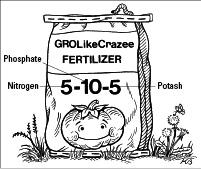Vegetable Gardening (109 page)

 How to detect too little or too much:
How to detect too little or too much:
A micronutrient deficiency or excess may mean that your soil is too acidic or too alkaline, so you can correct the problem by changing the pH rather than by adding more nutrients. Deficiencies and excesses most often are noted on plants that are growing poorly and through soil tests.
 How to add them to your soil:
How to add them to your soil:
Sometimes, changing the pH sufficiently to increase micronutrient levels isn't practical, or you may need to give a plant a micronutrient quickly while you try to change the soil pH. In such cases, micronutrients are applied as
chelates.
Chelates are added to other chemicals, in this case micronutrients, to keep them available to plants when soil conditions are unfavorable. Apply chelated micronutrients to your soil, or better yet, spray them on plant foliage.
Fertilizing Your Vegetable Garden
Even if you have the healthiest soil around, growing vegetables is an intensive process that strips many important nutrients from the soil. So you need to add some fertilizer to your soil to keep it in optimum shape to feed your plants.
How much fertilizer you add depends on the soil and the plants you're growing. So it's difficult to generalize across the board on what type of fertilizer to choose and how much to apply. Soil tests are a great way to know what to add. Refer to Chapter 14 for more on soil tests.
Examining a fertilizer label
 Commercial fertilizers are labeled with three numbers that indicate the fertilizer's nutrient content (see Figure 15-5). The first number indicates the percentage of nitrogen (N), the second number shows the percentage of phosphate (the type of phosphorus, P
Commercial fertilizers are labeled with three numbers that indicate the fertilizer's nutrient content (see Figure 15-5). The first number indicates the percentage of nitrogen (N), the second number shows the percentage of phosphate (the type of phosphorus, P
2
O
5
), and the third number represents the percentage of potash (the form of potassium used, K
2
O). (I explain these nutrients in detail in the earlier section "Macronutrients.")
Figure 15-5:
A fertilizer bag is labeled with nutrient content.
For example, a 5-10-5 fertilizer contains 5 percent nitrogen, 10 percent phosphate, and 5 percent potash, and it's called a
complete fertilizer
because it contains some of each type of nutrient. In contrast, bone meal has an analysis of 4-12-0. It's a good source of phosphate but doesn't provide any potash. The other materials in a commercial fertilizer that the analysis numbers don't account for are generally filler — unimportant materials that add bulk to the bag so the fertilizer is easier to spread.
How much fertilizer do you use? Soil tests are the best way to correct deficiencies (see Chapter 14 for details), but fertilizer bags also give general dosage recommendations for gardens. Most fertilizer recommendations for maintenance fertilization (rather than to correct a deficiency) are made according to how much nitrogen a crop needs. So, for example, if you have a recommendation for 3 pounds of 5-10-10 fertilizer per 100 square feet, but the fertilizer that you have on hand is 5-5-5 fertilizer, apply 3 pounds of 5-5-5. Even though the 5-5-5 fertilizer's percentage of phosphate and potash is less than that of the 5-10-10, it offers the same recommended amount of nitrogen.
Choosing a fertilizer
Most home gardeners can grow a perfectly beautiful and productive garden using organic principles. In the last 20 years, an explosion of organic products (such as fertilizers) has hit the market, making gardening with this method much more accessible. I choose to garden with organic fertilizers, and I explain why in this section; I also warn you of the dangers of chemical fertilizers.
Organic fertilizers
Organic fertilizers
— animal and green manure, blood meal, fish emulsion, cottonseed meal, granite dust, and rock phosphate — have several advantages:
 Many organic fertilizers contribute organic matter to your soil, improving its structure, feeding soil microbes, fighting fungal and bacterial diseases, and contributing micronutrients.
Many organic fertilizers contribute organic matter to your soil, improving its structure, feeding soil microbes, fighting fungal and bacterial diseases, and contributing micronutrients.
 Most organic fertilizers supply a slow but steady diet for plants.
Most organic fertilizers supply a slow but steady diet for plants.
 Some organic fertilizers, such as manure and compost, may be inexpensive — or free if you create them yourself.
Some organic fertilizers, such as manure and compost, may be inexpensive — or free if you create them yourself.
 Complete organic fertilizers, such as 5-5-5, are now more widely available and have higher concentrations of nutrients than in the past, making them easy-to-use alternatives to chemical fertilizers.
Complete organic fertilizers, such as 5-5-5, are now more widely available and have higher concentrations of nutrients than in the past, making them easy-to-use alternatives to chemical fertilizers.
 However, it's not all sun and roses when using organic fertilizers. Here are some disadvantages:
However, it's not all sun and roses when using organic fertilizers. Here are some disadvantages:
 Some organic fertilizers, such as manures and compost, are bulky and difficult to store and transport.
Some organic fertilizers, such as manures and compost, are bulky and difficult to store and transport.

